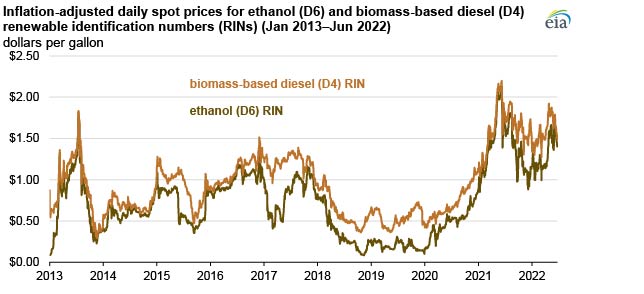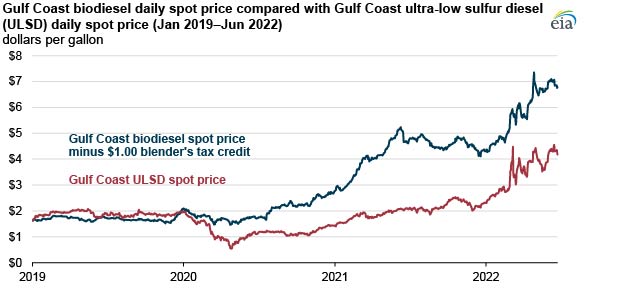
The prices of renewable identification number (RIN) credits—a compliance mechanism used for the Renewable Fuel Standard (RFS) program administered by the U.S. Environmental Protection Agency (EPA)—have remained high in 2022. So far this year, RINs generated by biomass-based diesel (biodiesel and renewable diesel) production, known as D4 RINs, peaked on April 28 at $1.91 per gallon (gal), and RINs generated by ethanol production (D6 RINs) peaked on June 7 at $1.68/gal, close to the high prices seen in 2021.
The RFS program sets annual targets, also called Renewable Volume Obligations (RVOs), for the amount of renewable fuels that must enter into the U.S. fuel supply to increase biofuels use. Petroleum refiners and importers of motor gasoline and diesel comply either by blending biofuels into petroleum-based fuels or by purchasing RIN credits. In general, RIN credit prices increase for two reasons.
The first reason RIN prices increase is when the cost of a biofuel is higher than the petroleum fuel it is blended into. In this case, blenders sell the RIN at a higher price so that they can offset the costs of the more expensive feedstock and continue blending at levels suitable for RFS compliance. Rising global demand for the agricultural feedstocks used to make biodiesel fuels has made biodiesel more expensive than petroleum diesel, driving D4 RIN prices higher in 2022 and creating an incentive to blend biodiesel and renewable diesel.
At its peak on April 28, the U.S. Gulf Coast spot price for biodiesel reached $8.36/gal. Even when accounting for a $1.00/gal biodiesel tax credit that blenders receive for blending biodiesel, biodiesel spot prices were more than $3.00/gal more expensive than the $4.30/gal U.S. Gulf Coast spot price for ultra-low sulfur diesel. This difference has decreased slightly since then to $2.52/gal as of July 11 but remains a large enough difference that high D4 RIN prices are needed to drive enough blended fuel to meet the RFS targets.

The second reason RIN credit prices increase is when RFS targets are set at a higher level than normal market-driven biofuel consumption can support. In this case, a higher RIN price encourages blending to the higher target level. The value of the higher RIN provides an incentive for blenders and retailers to offer higher biofuel blends at discounted prices to encourage higher consumption of biofuels to meet the increased RFS targets. So, the recent increase in D6 RIN prices is likely due to the higher RFS target announced by EPA on June 3, 2022.
The EPA announcement set the implied RVO target for ethanol at the statutory maximum of 15 billion RINs, the same as in 2019. This target is an increase from 2020 and 2021 targets, which were lower because of reduced driving demand during the COVID-19 pandemic.


Follow us on social media: